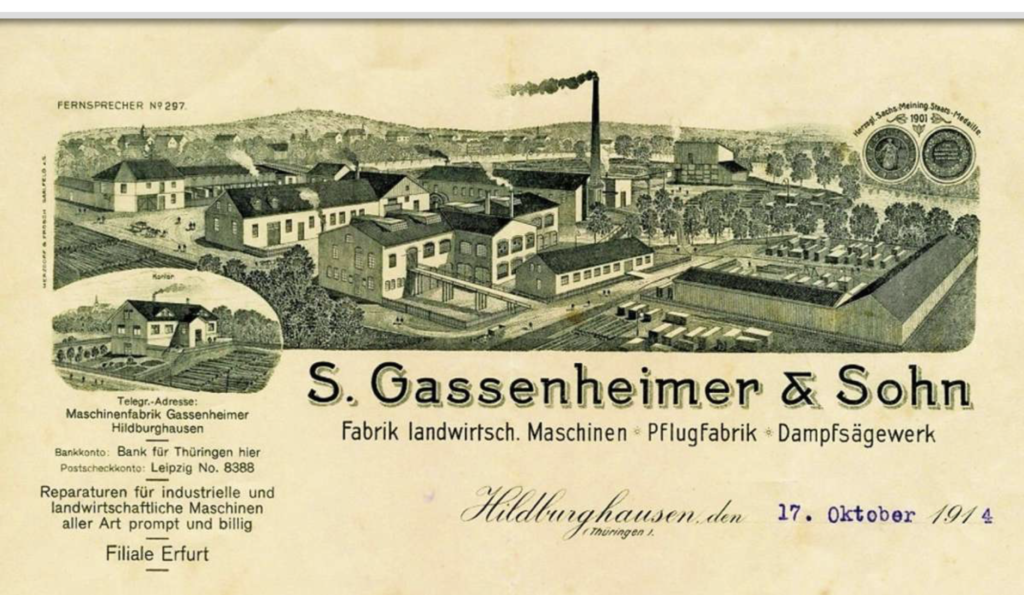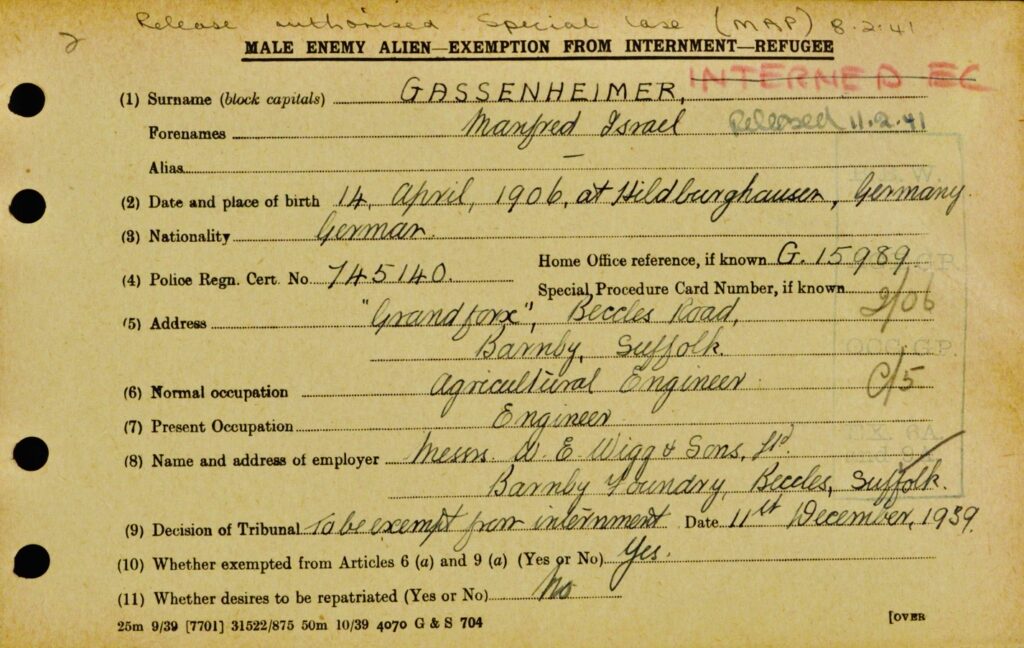See as well:
The Family of Isaac and Maile GASSENHEIMER
Descendants List of Salomon & Babette (née Wolfermann) Gassenheimer
The Windfege and the Gassenheimers
The family of Salomon & Babette Gassenheimer is the second branch of the Gassenheimer family that we are able to document with some confidence. This family played a critical role in the Jewish communities of Bibra and Hildburghausen and also contributes to our understanding of the Jewish communities in Erfurt and Eschwege.
Salomon, b. 1840, was the youngest of the three sons of Joseph and his second wife, Lotte Jette Salomon. The eldest son, Jacob, b. 1835, had lived only eighteen (18) months. This left Samuel, b. 1837, and Salomon to carry on the family business as the children of Joseph’s first marriage — Leopold and Sophia – were living in the United States.
In the early 1860s, the strategic business decision was taken that Samuel would move to Themar and establish the Gassenheimer business there. Salomon remained in Bibra; he not only continued the family business in the Bibra area but from 1868 on, he became co-owner of the Firma Gassenheimer in Themar. In the mid-1860s, Salomon married Babette Wolfermann of Barchfeld. Between 1869 and 1885, they had nine children — 5 daughters and 4 sons — all born in Bibra. Salomon’s father, Joseph, died in 1876.
By the late 1880s, the children of Salomon and Babette were making plans for their futures. It was probably assumed that the eldest son, Oskar, would lead the family business as Salomon became older. In 1890, the third son, 15-year-old Carl, went to Eschwege in 1890 as an apprentice; he remained there, forming a company in partnership with his brother-in-law, Jacob Steinhardt, husband of his younger sister Alma. Unlike the other Gassenheimer businesses, Firma Gassenheimer & Co. in Eschwege did not trade in agricultural machinery but instead produced sausage casings.
In 1892, the rest of the family, including mother/grandmother Babette, left Bibra for Hildburghausen. Here, Salomon established a branch of the Gassenheimer agricultural machinery business independent of the Themar business. The local Themar newspaper announced that agricultural machinery would now be available in Hildburghausen as well as in Themar.

Salomon Gassenheimer lived only six years after the move from Bibra; upon his death in August 1898, 29-year-old son Oskar carried on the business and his two younger brothers, 29-year-old Louis and 19-year-old Josef, joined him.
In 1908, the brothers made two significant changes: first, Josef Gassenheimer left Hildburghausen for Erfurt where he set up a branch of the family business, as reported in the Berliner Börsen-Zeitung/Berlin Stock Exchange Newspaper.
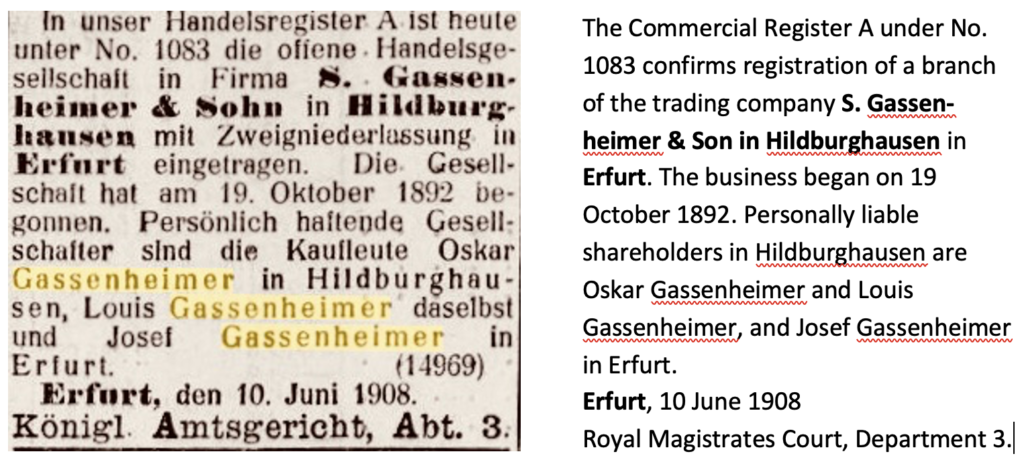
In Hildburghausen, Oskar and Louis bought the site of the former Wiesenmühle/mill (built in 1717) on the Werra River: initially, they developed a wood-processing and box making business, but soon started to expand into manufacturing products such as machines, equipment, vehicles, and tools for agriculture and domestic needs. They also offered repair services of all kinds. By the First World War, S. Gassenheimer & Sohn was a major industrial enterprise and profited by supplying the German army during the war.
In 1927, Oskar Gassenheimer died; Louis continued the business with his wife, Helene, as partner. The years of inflation were challenging but the Gassenheimer business came through the crisis and by 1930 approx. 40 employees were working in the business, which was processing approx. 2,000 fm of roundwood annually, also for contract cutting.1http://www.schildburghausen.de/geschichte-der-juden/
The sons of Salomon and Babette all married and formed families: Oskar married Clothilde Erdmann, and their daughter Ilse was born in 1896. Louis married Helene Hirsch of Schweinfurt, and they had three children — one daughter and two sons. Carl married Ida Heinemann, also of Schweinfurt, and their daughter, Käte, was born in 1907 in Eschwege. Josef married Sidonia Fuld of Mühlhausen and their family consisted of three daughters.
*****
Only one of the five daughters of Babette and Salomon remained in Hildburghausen. This was Hedwig, b, 1871: she married Jacob Sommer of Soest who moved to Hildburghausen. They had seven (7) children, one of whom, Siegfried Jacob, died in early adulthood in 1918. Two sisters moved to Eschwege: in 1902, Alma married Jacob Steinhardt who went into business with Carl Gassenheimer and two children, Lucie (b. 1904) and Werner (b.1914), grew up in Eschwege. Rosalie also lived in Eschwege, married to an Isidor Horwitz. In 1905, they had a daughter, Charlotte, called “Lotta.” Paula, the youngest child, married Simon Wolf Theisebach in 1911, and they had a son, Heinz, in 1912 and a daughter, Hildegard, b. 1919. They lived in the area around Frankfurt a/Main.
*****
In January 1933, when the Nazi Regime began, two of Salomon’s and Babette’s children were dead: Oskar in 1927 and Ricke in 1931. We can identify 54 family members who were alive and in Germany. Two of Some made plans to leave Germany as quickly as they could, either for another country in Europe or outside of Europe altogether. The first to leave was Werner Steinhardt, Alma (née Gassenheimer) Steinhardt’s son; in June 1933, he went to South Africa. Alma’s daughter, Lucie, moved to France.
Among the earliest family groups to leave were the those of two sisters, Paula Theisebach, née Gassenheimer, and Hedwig Sommer, née Gassenheimer. Paula died in Giessen on 18 July 1936; her children, Heinz and Hildegard, who had received visas to enter the United States in early July, sailed from Hamburg to the United States on 23 July 1936. Paula’s husband, Simon Wolf Theisebach, followed in September 1936. On 2 August 1936, Hedwig Sommer, née Gassenheimer, who was now divorced from husband Jacob Sommer, left for Venice. Her son Arno, daughter-in-law, Mira (née Grünbaum) and grandson, Sigfried (b. Jan 1936), either accompanied her or followed.
Erna Heinemann, née Gassenheimer, daughter of Josef Gassenheimer headed to South Africa and, while we do not know the exact date, she probably left before November 1938.
The Nazi Regime targeted the Gassenheimer company in Hildburghausen. In March 1937, Louis Gassenheimer was forced to sell, for a paltry sum, the business to Nazi arms manufacturer “Paul Kätsch KG” from Sömmerda. After some reorganization and repurposing, the company opened under its new management on 24 April 1937. The company produced ammunition boxes, barrack parts, screws, barrel turning parts, jigs and fixtures, small machines, gauges and measuring tools, as well as auxiliary bicycle engines. The main customer was “Rheinmetall Sömmerda,” an industrial manufacturer of war materiel for the Reich. The impact fuse for shipboard weapon ammunition developed in the factory became an important product.’ Until the beginning of the war, about 140 workers were employed, later up to 360. Production was partly reorganised and a metal department set up (screws, moulded parts, manufacture of small machines). In the former woodworking department, mainly ammunition boxes, lockers, etc. for the Wehrmacht were produced, and in the carpentry department, roof constructions for barracks and hangars for aviation and the Luftwaffe.
*****
The 1938 Novemberpogrom made the Nazis’ intentions for German Jews crystal clear. The three Gassenheimer brothers — Carl in Eschwege, Louis in Hildburghausen, and Josef in Erfurt — were rounded up and taken to Buchenwald. Josef Gassenheimer did not survive ‘protective custody’ at the camp; he was murdered in Buchenwald on 29 November 1938. Carl Gassenheimer was so brutalized in Buchenwald that he returned to Eschwege after four weeks barely alive. In May 1939, he and Ida moved to Berlin. Upon his return from Buchenwald, Louis and his wife, Helene, were forced to leave Hildburghausen and move to the nearby village of Römhild.
The pogrom prompted a surge in the search for safe refuge, and at least nine more family members left Germany: the family of Oskar and Clothilde’s daughter, Ilse Katz, née Gassenheimer, her husband, Edwin, and daughters Eva (and her husband) and Inge were all in the United States by March 1940. Manfred and Günther Gassenheimer, the sons of Louis and Helene, both escaped.
Upon his release from Buchenwald, Manfred was able to gain entry into England; however, he was not able to take his wife, Inge (née Weiss) with him, and she returned to Berlin to live with her parents, Max and Else (née Cohn) Weiss. Initially, when Manfred met the Enemy Alien Tribunal on 11 December 1939, he was declared exempt from internment and he worked as an engineer in Barnby Suffolk; when Germans invaded France in June 1940, however, he was rounded up as an “Enemy Alien” and interned until his “Release [was] authorized [as a] special case” on 08 February 1941.
In summer 1939, Günther Gassenheimer managed to escape from Germany from Munich. He reached the Chinese port city of Shanghai on 17 July 1939 on the steamer Athos II, only a short time before free entry to Shanghai was ended by the enactment of a restrictive permit system. After his arrival, Gassenheimer lived as a subtenant with the Hirsch family at 34 Chusan Road in the Japanese-occupied district of Hongkew. The “Emigrant Address Book for Shanghai” of 1939 listed him as a teacher, and he later also had a position at the S. J. Y. A. School, although it is unclear in which period.”2https://www.lexm.uni-hamburg.de/object/lexm_lexmperson_00006944
The family of Hedwig’s daughter, Margarethe/Grete Sztajnsznajder/ Steinschneider, née Sommer, left Hannover for Palestine: her husband, Eliezer, had been born in Poland, possibly Warsaw, her son Theodor, b. 1920 in Hannover, and Gisela Naomi, b. 1923, Alfeld. When exactly they left, we do not know, but the entry in the Jewish Holocaust Memorials and Jewish Residents of Germany 1939-1945 suggest that it was in 1939 or later.
Several found refuge in death: Carl Gassenheimer died in July 1941 just 1½ months before the Nazi Regime made the decision to deport German Jews to the ‘east’ to die. On 15 October 1941 — as the first deportations were preparing to leave — Clothilde Gassenheimer, Oskar’s widow, died in hospital in Frankfurt am/Main.
*****
In September 1941, as it became clearer that more drastic measures would be taken to remove Jews from the German Reich, twenty-seven (27) members of the family of Salomon and Babette Gassenheimer were trapped in occupied Europe — in Germany, France, Italy, Yugoslavia, Belgium, and the Netherlands. By the time the deportations of German Jews from German cities to ghettos in the ‘east’ began on 16 October 1941, two members had been murdered in occupied Yugoslavia.
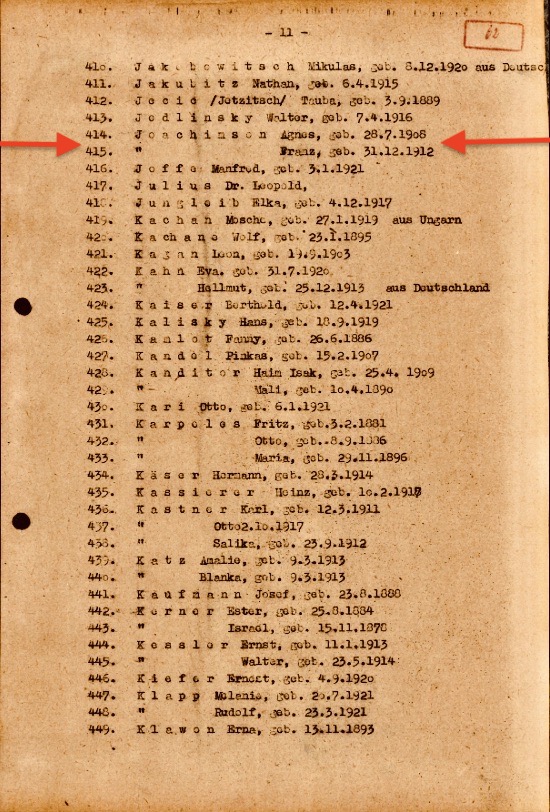
In early October 1941, the youngest child of Hedwig Gassenheimer, Agnes, was murdered with her husband, Franz Joachimsohn, in Yugoslavia. Agnes and Franz had been part of an illegal Jewish refugee transport that had left Vienna on 25 November 1939 hoping to reach Palestine. But when the Danube Rive froze earlier than usual, the refugees had had to overwinter in the Yugoslav river-port of Kladovo. In 1940, they waited in vain on a sea-going vessel for the onward journey, and eventually they had to move to the port of Šabac on the Sava, where they were caught by the Nazis in 1941. Only about 200 young people, as well as a few adults, could be saved or escape on their own. Agnes and Franz did not escape. Their names are on the list of those executed in October 1941.
Trapped throughout occupied Europe were twenty-nine (29) members in Germany, France, Italy, and the Netherlands. four of Salomon and Babette’s children — Louis Gassenheimer in Hildburghausen, Hedwig Sommer in Venice, Alma Steinhardt in Eschwege, and Rosalie Horwitz in Belgium — and three daughters-in-law — Ida, widow of Carl, Helene (wife of Louis), and Sidonia (widow of Josef) — were trapped in occupied Europe when Hitler decided to deport German Jews to the ‘east’. Of these six, one — Ida Gassenheimer — went underground in Berlin.
Five were deported: Sidonia Gassenheimer on the 10 May 1942 transport to Belzyce Ghetto; Louis Gassenheimer, his wife Helene, and his sister Alma Steinhardt on the 19/20 September 1942 to Theresienstadt Ghetto. Ten (10) other members of the Gassenheimer family were also deported to Theresienstadt Ghetto, as was Jacob Sommer, Hedwig Sommer’s divorced husband. Hedwig Sommer was rounded up in Venice in 1943 and taken to Auschwitz to be murdered.
At the end of WWII, Ida and her sister-in-law, Helene, were alive. Helene, who survived Theresienstadt, travelled to the United States to join her sons Manfred and Günther in California.
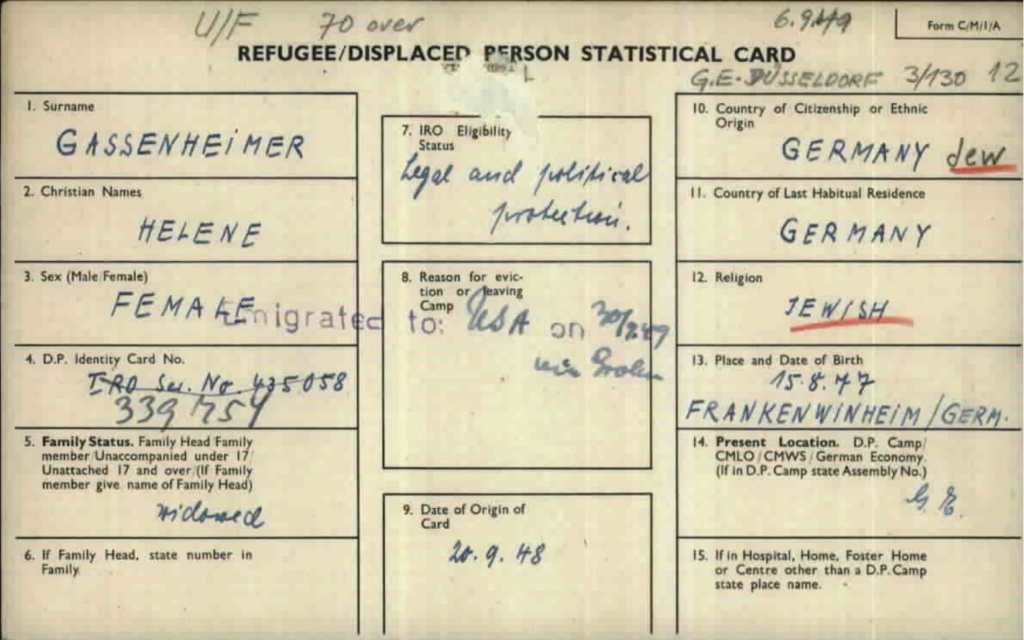
Ida, who survived four years in the underground, left Germany in 1947 for London to join her daughter, Käte Cohn (née Gassenheimer). Here she published a memoir, My underground life in Berlin 1941-1945, London: Wiener Library.
Of the grandchildren who may have been in occupied Europe in late 1941, we know that three were murdered, all children of Hedwig Sommer. Jenny Sommer had been living in Frankfurt since at least May 19393with two other Sommer women, Martha (née Hamburg), b. 1870, and her daughter, Georgina was deported on 12 November 1941 to Minsk Ghetto. Ludwig Sommer, who had been living in Hannover since at least May 1939, was deported on 15 December to the Riga Ghetto.
Arno Sommer, his wife, Mira, and their son lived through the war/Holocaust in Italy and in 1948 travelled to the United States. We believe that Alice Krauss, Louis and Helene Gassenheimer’s daughter, was in Düsseldorf and that her mother initially went there before travelling on to the United States on 4 October 1949. Here Helene joined her two sons: Günther who had arrived in May 1947 from Shanghai and Manfred who travelled with his wife, Edel, from England to the States in June 1948. The whereabouts of Lucie Kleefeld, née Steinhardt, Alma’s daughter, are not clear but she was living in Paris in 1982 when she submitted a Page of Testimony to the Yad Vashem to honour her mother. We do not yet know the story of the family of Paula Schmidt, née Gassenheimer. Her husband, Julius, and their daughter Edith Baer, née Schmidt, were in the Netherlands during the war: Julius was deported to Bergen-Belsen on 01 Feb 1944. We do not yet know the wartime story of Edith and her husband, Ernst, and their daughter, Lore, who was born on 26 Aug 1938 in Amsterdam. The family left Europe after the war, sailing from Rotterdam to New York on 28 March 1947.
We welcome any information that will add to the story and of course any corrections to what is written here. Please contact Sharon Meen at [email protected]
it is spelled “Sztajnsznajder” and this spelling is used by her daughter in applying for citizenship in Palestine in 1943. However, in the Page of Testimony submitted in memory of her mother, Grete signed her name as “Grete Steinschneider.” We cannot find records of Greta’s immigration into Palestine probably because she and her family immigrated into Palestine before 1937, which is the year when records are available to the internet researcher.4Search in Mandatory Palestine Naturalization Applications, 1937-1947, available in MyHeritage There is a record for the application for naturalization by Gizela Kauf, née Sztajnsznajder, in the database and the birthdate is a match for that of Naomi Steinschneider, so we expect the name may well be Gisela Naomi Kauf, née Steinschneider.
